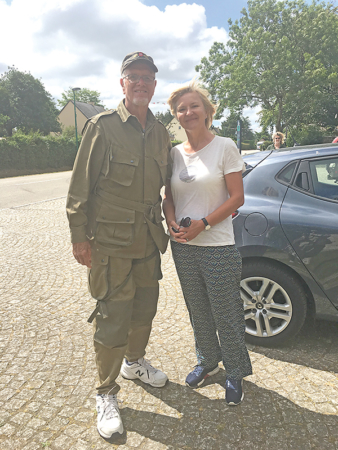I would imagine that to most Americans, thoughts of Normandy include Omaha and Utah beaches and the American Cemetery and Memorial, where 9,388 soldiers are honored in their final resting place.
But as you go inward from those historic beaches, Normandy is one of the 18 regions of France, much like the individual states that comprise our country. It is home to 3.3 million people, about 5% of the French population. It comprises 11,547 square miles, about the size of the state of Maryland, which ranks 42nd among our 50 states. Much of Normandy consists of agricultural and cattle breeding activities and in the summer months, is bristling with tourists.
The countryside is dotted with many small towns, many of which are smaller than Montgomery. They looked strikingly similar. All feature town squares with churches as the centerpieces. The buildings are constructed of brownstone, much as you would see in history books. American flags are everywhere, and each community has commemorative markers of what took place during the war.
I was surprised to see the same type of ‘hero’s banners’ that are prevalent in our own communities. Each of the towns we visited displayed these same banners lining their streets, each one containing the names and photos of American soldiers who had fought there.
But everywhere we went, there were remnants of the German fortifications known as ‘the Atlantic Wall.’ From March of 1942 leading up to the D-Day invasion, the Germans had constructed a 2,000-mile line of 15,000 steel and concrete emplacements intending to repel an Allied land invasion. They were made using 1.2 million tons of steel and 15 million cubic meters of concrete, the equivalent of 1,100 Yankee Stadiums. Its cost at the time was $3.7 billion, equal to $200 billion in today’s cost. Three hundred thousand German troops manned these enforcements.
Despite what the Germans believed was an impregnable defense system and the heavy losses suffered by the Allied troops, most of these fortifications were overrun in a few days.
One Saturday morning, we visited the town of St. Mere-Eglise, which was the first Normandy town liberated by the American forces in the wee hours of June 6. It is best known as the site where American soldier John Steele was left dangling from the town’s medieval church as his parachute got caught on its tower. Today, a parachute and the likeness of a soldier hang in that very spot as a reminder of what took place.
Obviously, conspicuous, wearing WWII uniforms and riding in jeeps, a Frenchman approached me in the town square and asked, “American, American.” When I replied, I was, he excitedly asked, “Picture?”
I nodded yes, and he waved for his three children to gather around me. He took several pictures, shook my hand, and repeatedly said, “Thank you, thank you.”
Feeling a bit uncomfortable by the attention, once again, J.P. gave the explanation.
“This will happen more than once before you leave Normandy,” he said. “The people here love Americans and are most grateful for what they did. If it weren’t for Americans, they’d all be speaking German now.” He was right on both counts.
We saw and experienced so much, time and space make it impossible to recount all. But several occurrences stand out in my mind.
On a Sunday morning, we visited a German cemetery just a few miles from the beaches. J.P. wanted us to see the differences experienced at the American cemetery. The cemetery was well kept, but darker in appearance. In the still of the morning, with just the seven of us there, I was struck by observing that each headstone marker contained the names of several soldiers.
It was explained to us that the Germans believed that no solider should ever be alone. Consequently, each marker listed the names of three or four soldiers buried there.
While there, a car drove up, and a German woman entered the cemetery. Despite language differences, I struck up a ‘conversation’ with her. She explained her father had fought there. I told her mine also had. She asked if he survived. When I told her yes, she said her father had also survived.
Then she looked at me and said, “I am not a Nazi.” I was chilled. Here were two people whose fathers had fought on opposite sides, standing in a quiet cemetery. We posed for a picture, embraced, and went our separate ways.
Later that day, we visited the home of a man who was 10 years old on D-Day. The Germans had occupied their home, and he and a younger brother were hiding in a near-by barn when the Americans arrived. The boy asked an American medic if he could help his brother, who was ill. The medic stopped and took the time to tend to the boy. He then moved on and shortly after was killed by a German bayonet.
Following the war, the man tried in vain to find the name of that American medic but to no avail. Then, one day, the granddaughter of General Eisenhower visited the area. The man sought her out and asked for help. Impressed, the granddaughter did just that and was able to learn the medic’s identity.
In appreciation, the man constructed a wall at his home detailing the medic’s deed and including the names of American paratroopers who had landed in the area. He calls the wall “The Wall of Honor.” He proudly displays it to all who stop by.
On another occasion, we traveled on a secluded road between heavy hedgerows and trees to a remote now-abandoned farmhouse that once served as the headquarters for a German general overseeing the German troops in the area.
The story was explained to us that the general had been called to attend a military briefing meeting several hours away on the evening prior to D-Day. As he was traveling to the meeting, he spotted aircraft overhead, which turned out to be Allied Pathfinders about to mark drop zones for the paratroopers. The general turned around to get back to his headquarters.
As he was returning, American GI’s emerged from the bushes and ordered him to halt. The general told his driver to run over the troops. The GI’s opened fire, killing the vehicle’s occupants. He became the first general killed in the battle, and his death momentarily delayed an organized German response to what was about to take place.
There we were, standing on the very spot where this occurred.
Not far away, we visited the German bunker that first spotted the Allied fleet off the Normandy coast about 5:00 a.m. on June 6.
Not only had the afore-mentioned German general been killed, but General Rommel had returned to Germany a day earlier to be with his wife on her birthday. When word from the bunker was relayed back to Hitler’s headquarters in Berlin, it was delayed in reaching Hitler.
As he went to bed on June 5, Hitler had given his bodyguards strict orders that he was not to be awakened before 9:00 a.m. on June 6. The bodyguards received the message from Normandy, but fearing reprisals, if they disobeyed his orders, they did not wake him with the news. The combined circumstances proved additional time for the Allies before a German high command response was issued.
There was one final place I had to visit. It was a town called Saint Lo, a place vividly described in Dad’s book.
In July 1944, the Americans targeted the city as it served as a strategic transportation crossroads. The proceeding bombardment caused heavy damage destroying 95% of the city.
In his journal, Dad had written: “No one will ever see or hope to see a town in worse shape than Saint Lo. It was leveled, not even a wall standing. To this day and forever, Vets will be using the expression ‘Let’s Saint Lo it.’ Bulldozers had to plow a street through it so we could move on.”
As we ate lunch in what is now a modern rebuilt Saint Lo, it all didn’t seem possible. But indeed it had happened. As we left town, I stopped at a ‘welcome to Saint Lo’ road sign, and with Dad’s book in hand, took a picture. Dad had indeed returned 75 years later.
The people we met, the places we saw, and the significance we gained made our seven days in Normandy a truly once-in-a-lifetime experience. Now it was off to Bastogne, and that horrible battle Dad was somehow able to survive.
(Note: This is the third of a four-part story of my July Normandy experience re-tracing the path my father, Ralph N. Lowery, took as a member of the Pennsylvania 28th Division during World War II.)





Leave a Comment
Your email address will not be published. Required fields are marked with *